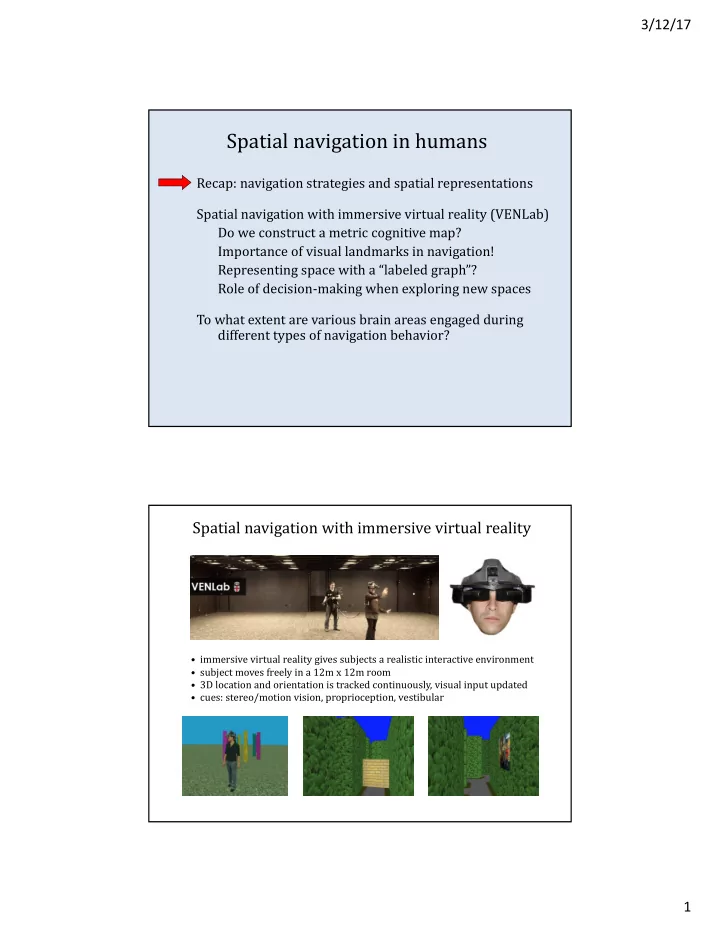

3/12/17 Spatial navigation in humans Recap: navigation strategies and spatial representations Spatial navigation with immersive virtual reality (VENLab) Do we construct a metric cognitive map? Importance of visual landmarks in navigation! Representing space with a “labeled graph”? Role of decision-making when exploring new spaces To what extent are various brain areas engaged during different types of navigation behavior? Spatial navigation with immersive virtual reality • immersive virtual reality gives subjects a realistic interactive environment • subject moves freely in a 12m x 12m room • 3D location and orientation is tracked continuously, visual input updated • cues: stereo/motion vision, proprioception, vestibular 1
3/12/17 Do humans combine traveled routes into a survey representation that permits metric navigation in the environment? • subjects learn two paths (home to blue, home to red) to remembered target locations • after training, walk novel shortcut between targets • if subjects represent metric information about distances and angles, they should be able to accurately walk the novel shortcut • if subjects rely on landmarks , expect more accurate performance for forest scene • poor performance for desert (questions metric map) • good performance for forest (landmarks important!) desert forest Further exploring the role of landmarks to guide navigation • same task as before • virtual world: desert with 7 posts • after training, translate or rotate posts near red target, on some trials • landmarks near start of shortcut help initial bearing, but then large errors accumulate • landmarks at end of shortcut act like “beacons” for navigation Also suggests that our “survey knowledge” is not accurate no change posts translated posts rotated 2
3/12/17 Spatial knowledge based on labeled graphs Chrastil & Warren (2014) Graph representations of spatial knowledge Graph in (a) only captures connectivity • nodes represent places visited • edges represent connectivity (routes) • enables detours Labeled graph in (b) includes metric info • connections have distances, nodes have angles between paths that meet at node • may be less precise than survey knowledge • good enough for finding efficient routes or detours, novel shortcuts Exploring sources of spatial knowledge Subjects explored maze for 10 mins to learn locations of 8 objects • active vs. passive (free vs. guided) Different cue combinations: • visual + vestibular + podokinetic (walk) • visual + vestibular (wheelchair) • visual (video) Testing (2013 study): • walk along novel shortcut between pair of objects, using remembered locations ( as the crow flies , with no visual input) • survey knowledge needed for this task 2014 study: • no visual + vestibular condition • walk shortest path within maze corridors • occasional barriers to force detours • route/graph knowledge needed for this task Chrastil & Warren (2013, 2014) 3
3/12/17 After completing experiment, subjects given list of objects and paintings, asked to sketch a map 2014 study 2013 study After training, walk between two learned objects using shortest path possible 40% trials: barrier appears, requiring detour from plan Experienced paths between During test, walked the shortest sink and bookcase novel path between sink & bookcase 4
3/12/17 Para-hippocampal Medial temporal lobe Retrosplenial complex place area Hippocampus Encodes a cognitive map that Identifies landmarks Uses landmarks to represents landmarks and determine the current goals in terms of coordinates location and direction in allocentric space CN To what extent are these brain areas engaged during different types of navigation behavior? Neural evidence supports a novel framework for spatial navigation Elizabeth Chrastil (2013) I turned 30 ◦ and walked 5 m from Turning right at the bank my initial heading and location takes me to the market, (EC, HC) turning left takes me home (HC, CN) CN Turn left at the bank (HC, CN) Down this street, first I will encounter the bank, then City Hall is at the corner the market, then the school of Main and Broadway (HC) (HC) I’m at the bank, which is on the west I turn right on 5th street, side of town, near the fire station I’m at the bank then left on Broadway, (PH, HC, EC, RSC) (PH) then go four blocks, and I will need to make City Hall is on the left a turn at the bank (HC, RSC) (PH) 5
Recommend
More recommend